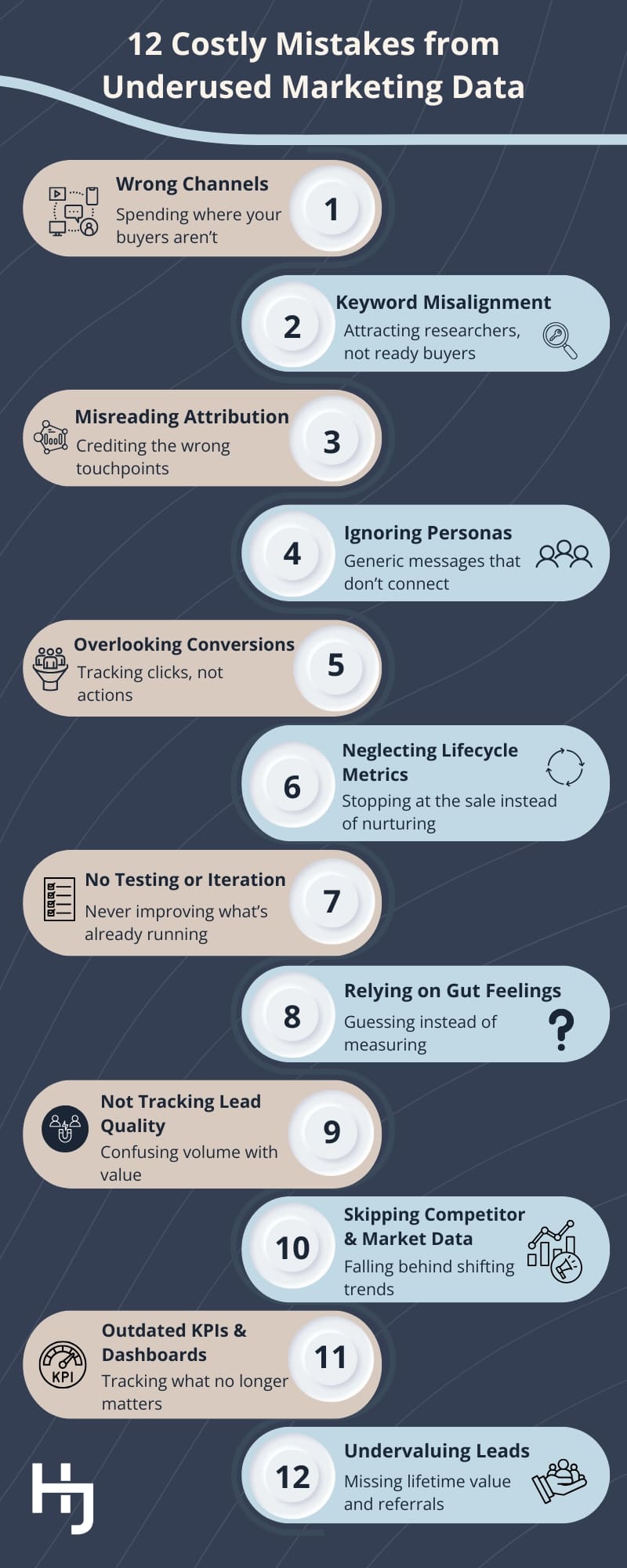 Did you know that 73 percent of small businesses aren’t sure if their marketing strategy is contributing to their goals, per Constant Contact surveys? This is concerning by itself, but to add to it, the majority are investing more time and money into their marketing to try to compensate for the knowledge gap. I understand this approach because I work with business owners every day who have done the same, but this is a data problem, and allocating more resources will not solve the underlying issue. It only means more of your finite resources will be wasted.
Did you know that 73 percent of small businesses aren’t sure if their marketing strategy is contributing to their goals, per Constant Contact surveys? This is concerning by itself, but to add to it, the majority are investing more time and money into their marketing to try to compensate for the knowledge gap. I understand this approach because I work with business owners every day who have done the same, but this is a data problem, and allocating more resources will not solve the underlying issue. It only means more of your finite resources will be wasted.
Give me a few minutes, and I’ll walk you through what happens when you underutilize your marketing data, review some common examples of mistakes that happen when data isn’t being used effectively, and cover some tips on how to move to a data-driven marketing strategy without overwhelming yourself or your team.
Consequences of Underutilizing Your Marketing Data
You may already have some idea of what underutilizing your marketing data means for your business, but let’s start with a quick review so it’s clear what you stand to gain.
Wasted Resources and Missed Opportunities
Marketing budget waste is a major concern, with 37 percent of marketers saying they’ve wasted marketing spend due to low-quality data, Forrester reports. According to their estimates, 21 percent of all paid marketing spend goes to waste. Other sources echo their sentiment, with ineffective spend absorbing up to 60 percent of total digital budgets, per Proxima. Naturally, when your budget is being funneled into ineffective tactics, that means you’re missing out on the effective ones.
Misunderstanding the Customer and Market
Only one-quarter of marketers are confident about their audience data, Nielsen reports. Other sources dig a bit deeper. For instance, just 42 percent of marketers know basic demographic information about their target audience, according to HubSpot. The rates drop even lower for more specific data, such as their purchase history, shopping habits, or where they consume content. Simply put, if you don’t understand your customers, you can’t hope to reach them.
Lost Customers
Customer loss is one of the most serious consequences of underutilizing marketing data because it doesn’t just affect growth, it erases progress. In all, 30 percent of businesses say they’ve lost customers due to their data, Forrester surveys say.
When your data isn’t accurate or fully leveraged, it’s easy to miss signals that would have kept those customers engaged. Maybe they weren’t reached at the right time, or the message didn’t align with what they actually needed. Either way, once customers leave, winning them back costs far more than keeping them in the first place.
Competitive Disadvantage
When businesses don’t fully understand their customers or the market, their plans stall. In all, 45 percent of product launches are delayed at least one month, and failure to meet customer requirements is a leading cause, Gartner reports. While those delays pile up, competitors with better insight into customer expectations are already in front of buyers, claiming market share. The same is true of your campaigns. If you aren’t reaching your customers, someone else almost certainly is.
12 Costly Mistakes Businesses Make by Underutilizing Marketing Data
Now that we’ve seen what happens when you’re not leveraging marketing data effectively, let’s explore what it looks like in practice.
1. Investing in the Wrong Channels
It’s easy to put money behind the wrong platforms when the decision isn’t backed by data. For instance, a B2B company might spend heavily on Instagram because engagement looks strong, even though the actual decision-makers are on LinkedIn.
Tracking where qualified leads originate in your customer relationship management (CRM) software or which sources bring in real sales conversations, and reviewing the data regularly, helps ensure your spend goes to the right places.
2. Keyword Misalignment

If you aren’t leveraging data as you build your PPC keyword strategy, you’re likely to have keyword targeting errors like search intent mismatch. For instance, let’s say you run a software company, and you see that the term “project management” has a high number of searches. This is only a partial picture. A generic phrase like that is more likely to draw in people researching the topic instead of companies ready to buy. That’s where your money will go, rather than to active buyers.
A quick review of paid search performance usually makes the problem clear. If you know your customers well, sometimes you can even look at your search term report and identify these mismatches before they eat away at your budget, too.
3. Misreading Attribution
Attribution can easily give a false sense of what’s working if the data isn’t tracked and managed well. For example, someone might click an ad once, do more research, and then come back a week later through another channel to get in touch. If you only credit that last touchpoint, it looks like the ad didn’t matter, even though it’s the reason your lead started their journey. When that happens, budget gets pulled away from touchpoints that are driving results in the background.
Ensure you’re tracking where leads come from. Look beyond a single interaction and seek to understand how channels work together, so you can get a more accurate picture of what’s moving buyers forward.
4. Ignoring Personas and Audience Segmentation
People utilize your product or service for different reasons. They’ll have different motivations, unique requirements in a solution, and distinct objections when selecting a solution, too. Yet, many businesses treat everyone the same way or create messaging that’s too broad to connect with anyone.
It’s essential to study your audience and generate personas that represent your real-world customers. From there, you can develop campaigns that speak to specific needs and priorities instead of a single, one-size-fits-all approach. When this data lives in your CRM as well, it’s easy to provide unique messaging that resonates with your contacts, too.
5. Overlooking Conversion Data

Traffic alone can look encouraging, but it doesn’t tell you if your marketing is working. For example, a campaign might drive steady visits to a landing page, but if no one fills out the form or books a call, that traffic isn’t moving the business forward.
Conversion data shows where interest turns into action. Track it and review it often. This will help you spot what’s working, so you can allocate more resources to successful strategies. It can also help you identify weak areas and make improvements.
6. Neglecting Lifecycle Metrics
Lifecycle metrics are key performance indicators (KPIs) that track a customer’s engagement and progress through the different stages of their journey with your brand. While many businesses have some understanding of the bottom of funnel metrics relating to acquisition or conversion, few develop strategies that genuinely connect with people and carry them through the different stages. Moreover, most brands arguably stop tracking after conversion. Yet, strengthening relationships to retain customers and cultivate loyalty are just as important.
Each stage will have its own metrics to track. You can also track the number of leads and customers that move through each stage and compare it to the previous stage to understand which parts of the customer journey require greater reinforcement.
7. Failing to Test and Iterate
Oftentimes, businesses will launch a campaign or asset and consider the task done. But if you don’t ever challenge your assumptions about what works, you can’t improve the results. Moreover, even successful assets will likely see diminishing returns over time as audience needs change and messaging becomes tired.
Build A/B testing into your routine. Even small experiments, like adjusting ad copy or landing page structure, can uncover better-performing approaches.
8. Relying on Gut Feelings
You know your business, probably better than anyone else. That knowledge is valuable and can help guide your strategies, but it’s not a substitute for data. For instance, you might want to focus on promoting a feature or service that you’re especially proud of, and it might even be something customers are excited about. However, if it doesn’t address their primary concerns, they won’t stick around long enough to find out.
People also have the tendency to gravitate to the areas they’re more familiar or comfortable with. For example, you might spend most of your time marketing on Facebook because it’s what you know. However, if your customers are on LinkedIn, that’s where you need to be.
Your data will show you these things and more. Sometimes, the results will surprise you.
9. Not Tracking Lead Quality
Getting lots of leads can make it seem like everything is going in the right direction. But do you know which leads actually become customers, convert the easiest, are most profitable, and can be retained? All of these things matter.
Once you have this level of data, you know where to focus your resources, so you’re not just getting leads, you’re actively growing your business and becoming stronger.
10. Skipping Competitor and Market Data
When you make decisions without keeping an eye on the market, shifts catch you off guard. Competitors adjust their messaging, pricing, or offers, and you keep running the same campaigns, unaware that the ground has already shifted. By the time performance starts to dip, they’ve already pulled ahead.
Competitor and market data give you early warning signs. When you understand where the market is moving, you can adapt before your buyers’ attention moves somewhere else.
11. Failing to Update Dashboards and KPIs
Old metrics create a false sense of performance. If your KPIs don’t evolve with business goals, your “good numbers” can still lead to losses. You may see strong results on paper while revenue growth slows, customer behavior shifts, or key opportunities pass you by.
When dashboards and KPIs reflect your current priorities, you can see what’s actually moving the business forward instead of chasing the comfort of outdated numbers.
12. Undervaluing Leads
Sometimes businesses get a bit of sticker shock when they see metrics like cost per click (CPC) or cost per lead (CPL). For instance, if you’re in the business services sector and running Google Search ads, each click costs more than $5, per WordStream. The average CPL is over $100. It’s one of the more resource-intensive areas to be in. But what if that lead, when converting to a customer, brings you $50,000 over the lifetime of your relationship? The investment makes a lot more sense. Even if you’re only onboarding a small fraction of these leads, the investment still makes sense.
Unfortunately, when businesses don’t know their customer lifetime value (CLV), they become hesitant to make these kinds of investments. You might set a maximum cost per click of two or three dollars, thinking you’re being fiscally conservative, but what really happens on the back end is that your ad does not show for the customers most likely to move forward.
Even businesses that do calculate their CLV don’t always capture the true value by failing to recognize that happy customers refer, and this adds up over the lifetime of the relationship.
When you know your CLV and include the ripple effect of referrals, it’s much easier to reverse-engineer your marketing budget. Moreover, you invest in your marketing initiatives with confidence, ultimately bolstering your business and accelerating your growth.
Quick Tips for Developing a Data-Driven Marketing Strategy
Shifting to a data-driven approach doesn’t mean overhauling everything at once. The goal is to make smarter decisions by using the information you already have more effectively.
Start with Your Core Goals
Identify what growth actually looks like for your business. Clear goals guide which data matters most and keep your dashboards focused.
Know What to Measure (And Why)
Track the metrics that connect directly to revenue, retention, and pipeline strength. This keeps you from chasing surface-level numbers.
Invest in Analytics
You can use a free platform like Google Analytics to gather data. If you pair it with a CRM that allows you to store your data and associate it with contacts for easy tracking, reporting, and segmentation, you’re in a good position. This is enough for most small-to-midsize businesses, though setup does require a certain degree of expertise.
Connect Data to Real Decisions
Build regular check-ins to review what your numbers actually say. If the data isn’t influencing how you spend or work, it’s just noise.
Keep Your View Current
Just one in five marketers say their data is fully integrated with the tools they use, HubSpot reports. Dashboards, KPIs, and performance reports should draw from a single source of truth and evolve with your strategy.
Build in Testing Loops
Treat campaigns as living systems. Test, adjust, and repeat to avoid stagnation and find hidden opportunities.
Get Help Developing a Data-Driven Marketing Strategy
Your business probably has access to a wealth of data that can help improve your marketing results. However, if you’re not collecting, storing, or leveraging it effectively, you’re likely making some of the marketing mistakes we’ve covered here, which often presents as slow or flatlined business growth. Sometimes businesses even begin shrinking. If you’re experiencing this and want to move toward a data-driven marketing strategy, I can help. Contact me for a complimentary consultation.
FAQs on Costly Mistakes Businesses Make by Underutilizing Marketing Data
How can marketing data help reduce wasted ad spend?
Marketing data shows which channels, audiences, and messages drive real results. By tracking what converts instead of what simply attracts clicks, businesses can shift spending toward high-performing tactics and cut investments that don’t generate revenue. This improves overall efficiency and protects the marketing budget from unnecessary waste.
What is keyword misalignment in PPC campaigns?
Keyword misalignment happens when the search terms you target don’t match what buyers are actually trying to find. It causes ads to attract people researching general information instead of ready-to-buy prospects. Reviewing search intent and paid search performance helps ensure keywords reach qualified audiences.
How does misreading attribution data affect marketing performance?
When attribution data is misread, credit goes to the wrong channels or touchpoints. This skews performance results and causes teams to cut what’s working or overinvest in tactics that don’t drive conversions. Accurate attribution helps reveal which interactions actually move customers toward a purchase.
Why is audience segmentation important in B2B marketing?
Audience segmentation ensures your message reaches the right people with relevant information. B2B buyers differ in roles, goals, and timing. Segmenting by factors like job title, industry, or buying stage helps tailor campaigns to each group, improving engagement and conversion rates while reducing wasted effort.
What are lifecycle metrics and why do they matter?
Lifecycle metrics track how leads move through each stage of the buying process. They show where interest fades or deals get stuck, allowing teams to address problems early. Monitoring lifecycle metrics gives a clearer view of marketing effectiveness and helps convert more leads into customers.
How often should marketing KPIs and dashboards be updated?
Dashboards and KPIs should be reviewed quarterly at minimum, and whenever business goals or market conditions change. Regular updates ensure you’re tracking what truly reflects performance. Outdated metrics can create a false sense of success and hide areas where improvement is needed.
How can data help identify high-quality leads?
Data highlights which sources and behaviors correlate with closed deals. By comparing lead characteristics, engagement patterns, and conversion rates, businesses can see which prospects are most likely to buy. This insight helps prioritize outreach and align sales and marketing on qualified opportunities.
How does competitor and market data improve marketing strategy?
Competitor and market data reveal changes in buyer needs, messaging trends, and pricing strategies. Tracking this information helps you adjust early instead of reacting late. It keeps your marketing aligned with what’s happening in your industry and helps maintain a competitive edge.
What are the first steps to building a data-driven marketing strategy?
Start by defining clear business goals, then identify which metrics connect directly to those goals. Gather reliable data from your CRM, analytics tools, and campaigns, and review it regularly to guide decisions. Testing and refining based on what the data shows strengthens performance over time.





































































